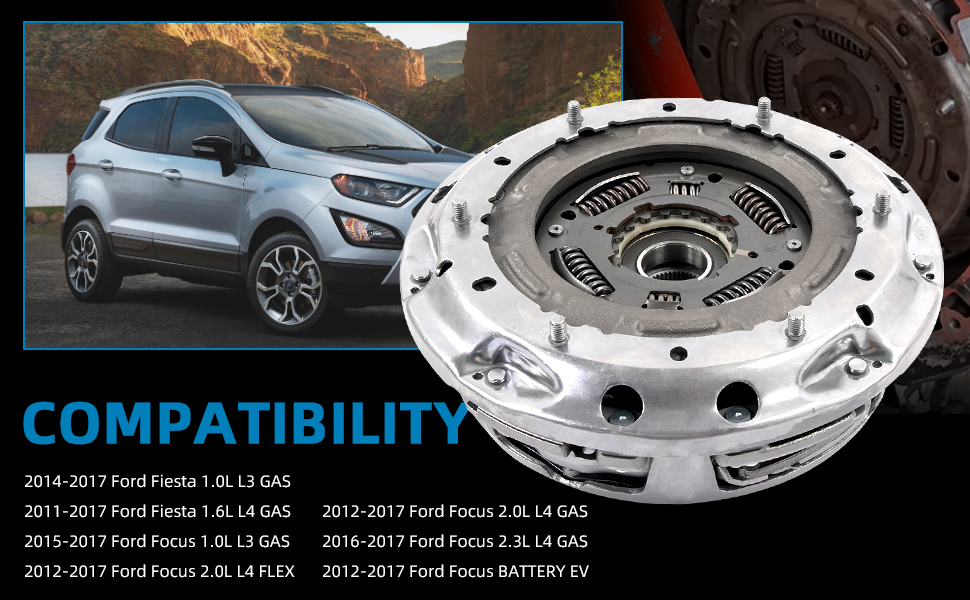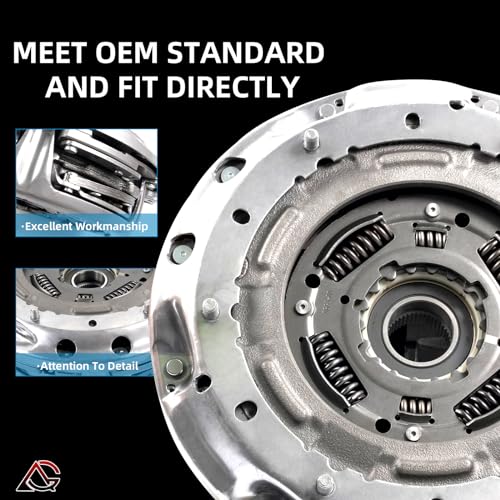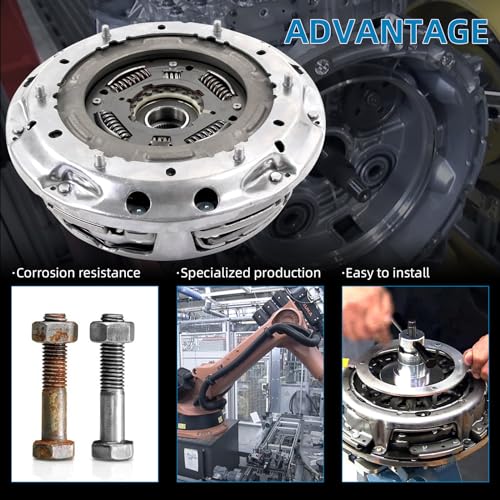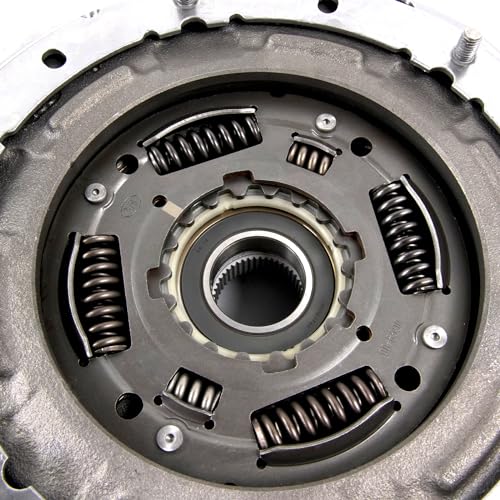6DCT250 Dual Clutch Transmission,Compatible with 2011-2017

6DCT250 Dual Clutch Transmission,Compatible with 2011-2017 Ford Focus Fiesta 1.0L/1.6L/2.0L/2.3L Engine DPS6-DCT
- 【Replacement part Number】6DCT250 DPS6
- 【Compatible with】Dual Clutch Transmission fit for 2011-2017 Ford Fiesta 1.0L/1.6L,Fit for 2012-2017 Ford Focus 1.0L/2.0L/2.3L/BATTERY EV
- 【High Quality Material】Material is heavy duty steel, high hardness and strong, surface is treated with antirust.
- 【Role of Dual Clutch Transmission】1. To enable gradual engagement between the engine and the transmission, thus ensuring a smooth start of the car; 2. Temporarily cut off the connection between the engine and the transmission, so as to facilitate gear shifting and reduce the impact of gear shifting; 3. When the car emergency braking can play a role in separation, to prevent the transmission and other transmission system overload, thus playing a certain role in protection.
- 【EASY INSTALLATION】Professional installation is recommended, use the DPS6-DCT Dual Clutch Transmission Reinstall Reset Tool to remove the old Dual Clutch Transmission and install it as a direct replacement for the original, you can also install it by watching the YOUTUBE video!
Pedal Troubleshooting
- Failure phenomenon: when the engine is idling, the clutch pedal has been pressed to the end, but it is difficult to shift gears, gear gears have impact sound. Barely hang on the gear, has not yet relaxed the clutch pedal, the car has been traveling or stalled.
- Check: remove the clutch bottom cover, put the transmission into neutral, the clutch to the end. Then, use a screwdriver to dial the slave disk. If it can be easily dialed, the clutch separation is good; if the dial does not move, the clutch separation is not complete.
- Exclude:
- 1、check whether the clutch pedal free travel is too large, and adjust.
- 2、check whether the height of the release lever is consistent, whether too low. Toggle the separation fork under the car, so that the front end of the separation bearing gently leaning on the inner end of the separation lever, turn the clutch for a week to view, if the inner end of the separation lever can be at the same time and the separation bearing contact is not on, indicating that the height of the separation lever is not consistent, should be adjusted. If the height of the release lever is the same, still separation is not complete, we must check the lever height. Separation lever will be adjusted to the same height, if you can completely separate, that the original improper adjustment or wear and tear is too much. Separation lever adjustment, must re-adjust the free travel of the clutch pedal.
- 3、if the above adjustments are normal, still separation is not complete, we must dismantle the clutch, check whether the slave disk is installed in reverse, whether the axial movement is difficult, whether the master slave disk has warped, whether the separation lever screw is loose, whether the floating pin is off.
- 4、for the new riveted friction plate clutch, to check whether the follower plate and friction plate is too thick. If too thick, add shims between the clutch cover and flywheel.
- 5、for hydraulic transmission clutch, in addition to the above checks, should also check whether the brake fluid is missing, whether the pipeline leakage and discharge the air in the hydraulic system.
When clutch slippage occurs, proper failure cause analysis should be performed.
- Causes of clutch slippage:
- 1、 Excessive wear of follower plate or exposed rivets;
- 2、Clutch pressure plate spring is too soft or broken;
- 3、The free travel of the clutch pedal is too small;
- 4、Clutch pedal free travel is too small. ④ Follower plate friction plate is oily or hardened by aging;
- 5、Loose clutch and flywheel joint bolt;
- 6、Clutch main pump oil return hole is blocked.
- Troubleshooting order and direction:
- 1、 Check the free travel of the pedal, if it is not in accordance with the standard value, it should be adjusted;
- 2、 If the free travel is normal, the clutch cover should be removed, check whether the clutch cover and the flywheel engagement bolt is loose, if loose, should be tightened;
- 3、 Observe whether there is oil thrown out from the edge of the clutch friction plate, if there is oil, it should be removed and cleaned with gasoline or alkaline water and dried, and then find out the source of oil and exclude it;
- 4、 If the friction plate is found to be severely worn, rivets exposed, aged and hardened, burnt and soaked with oil, it should be replaced with a new one, and the new friction plate should not be cracked or broken, and the depth of the rivets should be in accordance with the regulations;
- 5、 Check the oil return hole of the clutch master cylinder, if the oil return hole is blocked, it should be unblocked;
- 6、 If after the above inspection, adjustment and repair, still fail to eliminate the fault, then dismantle the clutch and check the spring force of the pressure plate spring. Pressure plate spring is good, should be the same length, such as uneven, should be replaced with a new product, such as a slight reduction in elasticity, length difference is not significant, can be adjusted under the spring plus or minus shims.
| SKU: | B0CSD37RDT |
| Weight: | 38.7 pounds |
| Dimensions: | 14.02 x 13.94 x 8.11 inches |
| Brand: | Aumzong |
| Model: | 6DCT250 |
| Manufacture: | Aumzong |
| Origin: | China |
Product Description



Pedal Troubleshooting
- Failure phenomenon: when the engine is idling, the clutch pedal has been pressed to the end, but it is difficult to shift gears, gear gears have impact sound. Barely hang on the gear, has not yet relaxed the clutch pedal, the car has been traveling or stalled.
- Check: remove the clutch bottom cover, put the transmission into neutral, the clutch to the end. Then, use a screwdriver to dial the slave disk. If it can be easily dialed, the clutch separation is good; if the dial does not move, the clutch separation is not complete.
- Exclude:
- 1、check whether the clutch pedal free travel is too large, and adjust.
- 2、check whether the height of the release lever is consistent, whether too low. Toggle the separation fork under the car, so that the front end of the separation bearing gently leaning on the inner end of the separation lever, turn the clutch for a week to view, if the inner end of the separation lever can be at the same time and the separation bearing contact is not on, indicating that the height of the separation lever is not consistent, should be adjusted. If the height of the release lever is the same, still separation is not complete, we must check the lever height. Separation lever will be adjusted to the same height, if you can completely separate, that the original improper adjustment or wear and tear is too much. Separation lever adjustment, must re-adjust the free travel of the clutch pedal.
- 3、if the above adjustments are normal, still separation is not complete, we must dismantle the clutch, check whether the slave disk is installed in reverse, whether the axial movement is difficult, whether the master slave disk has warped, whether the separation lever screw is loose, whether the floating pin is off.
- 4、for the new riveted friction plate clutch, to check whether the follower plate and friction plate is too thick. If too thick, add shims between the clutch cover and flywheel.
- 5、for hydraulic transmission clutch, in addition to the above checks, should also check whether the brake fluid is missing, whether the pipeline leakage and discharge the air in the hydraulic system.
When clutch slippage occurs, proper failure cause analysis should be performed.
- Causes of clutch slippage:
- 1、 Excessive wear of follower plate or exposed rivets;
- 2、Clutch pressure plate spring is too soft or broken;
- 3、The free travel of the clutch pedal is too small;
- 4、Clutch pedal free travel is too small. ④ Follower plate friction plate is oily or hardened by aging;
- 5、Loose clutch and flywheel joint bolt;
- 6、Clutch main pump oil return hole is blocked.
- Troubleshooting order and direction:
- 1、 Check the free travel of the pedal, if it is not in accordance with the standard value, it should be adjusted;
- 2、 If the free travel is normal, the clutch cover should be removed, check whether the clutch cover and the flywheel engagement bolt is loose, if loose, should be tightened;
- 3、 Observe whether there is oil thrown out from the edge of the clutch friction plate, if there is oil, it should be removed and cleaned with gasoline or alkaline water and dried, and then find out the source of oil and exclude it;
- 4、 If the friction plate is found to be severely worn, rivets exposed, aged and hardened, burnt and soaked with oil, it should be replaced with a new one, and the new friction plate should not be cracked or broken, and the depth of the rivets should be in accordance with the regulations;
- 5、 Check the oil return hole of the clutch master cylinder, if the oil return hole is blocked, it should be unblocked;
- 6、 If after the above inspection, adjustment and repair, still fail to eliminate the fault, then dismantle the clutch and check the spring force of the pressure plate spring. Pressure plate spring is good, should be the same length, such as uneven, should be replaced with a new product, such as a slight reduction in elasticity, length difference is not significant, can be adjusted under the spring plus or minus shims.





